Apple is the highest consuming fruit than other fruits as it is healthy and tasty. It is also considered the most profitable fruit crop because of its high consumption and medicinal value. Apple is an essential part of the rose family of the genus Malus. It is recognized as a temperate fruit that can be grown in mild-temperature regions.
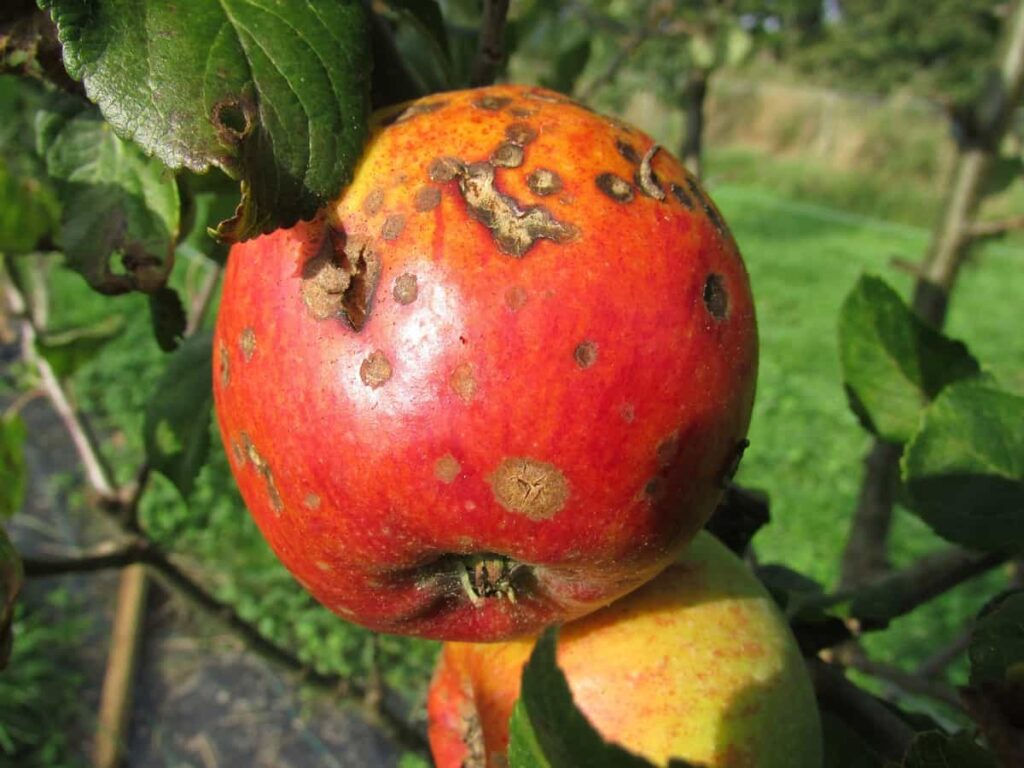
The fruit requires a considerable period of dormancy, well-drained soil, careful pruning, and a rigorous pest-management program for good growth. Below are the common pests and diseases affecting apple crops and their control methods. If you plan to cultivate apples, have a good knowledge of their control methods to control at the initial stages and reduce the yield losses.
how to control pests and diseases in Apple trees
Diseases in Apple trees
Apple scab
Crabapple and apple trees are most often affected by apple scabs. The fungus Venturia inaequalis infecting leaves and fruit causes scabs. Scabby fruit is often unfit for consumption. Fallen leaves and soil are the primary habitats of apple scabs during the winter. Generally, disease development occurs during spring and early summer when it is wet and cool.
The wind, rain or splashing water carry fungal spores from the ground to flowers, leaves, and fruits. Newly opened apple leaves are extremely susceptible to infection during damp or rainy weather. The disease can result in high crop losses for apple growers and is economically significant.
Disease symptoms
- Fruits and leaves are usually affected by the disease.
- The upper surfaces of the affected leaves develop black, circular spots and are twisted or puckered.
- Spots on the underside of leaves are velvety and may cover the whole leaf surface. Yellowing and dropping of severely affected leaves may occur.
- Flower stems can also be infected by scabs, causing them to drop.
- As the lesions develop, they may become sunken and brown, with spores around their margins
- The fruit becomes distorted and cracks, allowing secondary organisms to enter.
In case you missed it: How to Control Pests and Diseases in Papaya: Causes, Symptoms, Chemical, and Biological Management
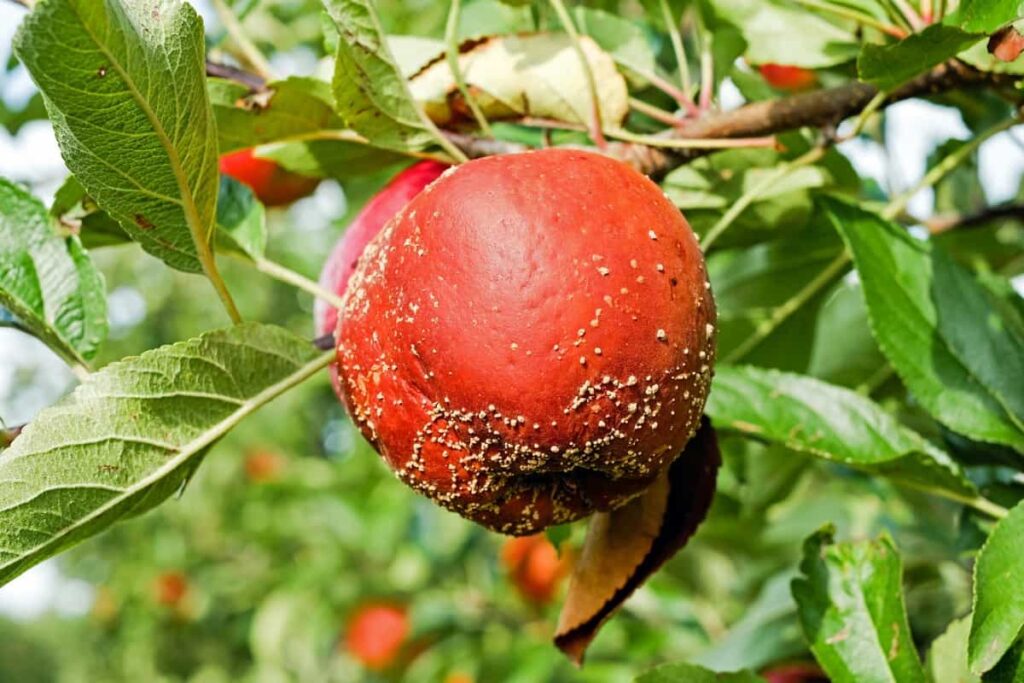
Chemical control and management
- For best control, spray liquid copper soap early, two weeks before symptoms normally appear. Alternatively, begin applications when the disease first appears and repeat at 7 to 10-day intervals up to blossom drop.
- A finely ground wettable sulfur powder is used in pre-blossom applications and must go on before rainy or spore discharge periods. Apply from pre-pink through cover (2 Tbsp/ gallon of water), or use in cover sprays up to the day of harvest.
Marssonina leaf blotc
A fungus called Diplocarpon mali causes the disease. For the fungus to show obvious symptoms, it takes about 40 days. Ascospores produced on overwintered leaves usually initiate primary infections. The release of spores is generally dependent on rain. The infection occurs when the temperature is 23.5°C and the rainfall is 20 mm. In the fruit development stages of Apples, high rainfall and moderate temperatures ranging from 20-22°C are conducive to the disease.
Disease symptoms
- The disease symptoms appear in the form of dark green circular patches on the leaf’s upper surface, giving rise to 5-10 mm brown leaf spots that become dark brown in due course.
- On maturity, it also develops on the lower surface of the leaf.
- Small black spots are visible on the surface of the leaf.
- The surrounding areas turn yellow when numerous lesions merge to form large dark brown scars.
Chemical control and management
- Each product of acid-clay Myco-Sin, Funguran (copper hydroxide), Curatio (lime sulfur), or sulfur should be sprayed ten to twelve times a year. Urea can also be applied to overwintering leaves to reduce the level of primary inoculum.
- Disease incidence can be significantly reduced by using fungicides with active ingredients like Mancozeb, dodine, and trifloxystrobin. Copper-oxychloride can also be applied after harvesting.
- You can use Fungicides in combinations with dodine and hexaconazole, Zineb and hexaconazole, and Mancozeb and pyraclostrobin to reduce the possibility of pest resistance.
- Mancozeb (0.3%), copper oxychloride (0.3%), Zineb (0.3%), HM 34.25SL (0.25%), Dodine (0.075%), and Dithianon (0.05%) provided complete disease control.
Black rot canker
Black rot is an important disease of apples caused by the fungus Botryosphaeria obtusa. The fungus can infect dead tissue and living trunks, branches, leaves, and fruits. The black rot fungi survive the winter in cankers on branches and in mummified fruit (shriveled and dried fruit) attached to trees. During wet weather, these infections release spores, which are spread by wind or splashing water.
Disease symptoms
- When the leaves open in the spring, leaf symptoms first appear.
- The lesions begin as small, purple specks on the upper surface of leaves that enlarge into circular lesions 3-6 mm in diameter.
- In the center of the lesions, the color changes from tan to brown, while the margins remain purple. Secondary enlargement of these leaf spots occurs after a few weeks.
- Chlorotic leaves become defoliated when heavily infected.
- The flesh of the rotted area is firm and leathery. The surface of infected fruit is often covered with black pycnidia.
- It is usually the result of a wound in the bark that causes lesions resulting in canker formation.
In case you missed it: How to Control Pests and Diseases in Onion Crop: Causes, Symptoms, Chemical, and Biological Management
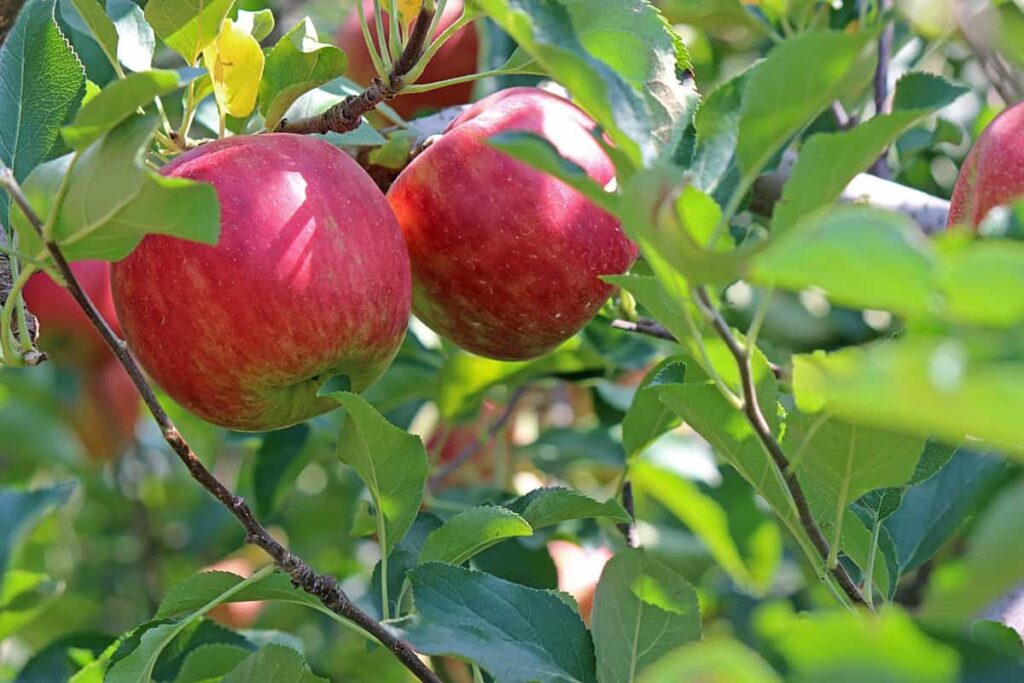
Chemical control and management
- Proper pruning should be done to avoid mechanical injury.
- Use Trichoderma viride or T. harzianum with neem cake
- General-purpose fungicides, like copper-based sprays and lime sulfur, can be used to control black rot
Collar rot
This disease is caused by the soil-borne fungus Phytophthora cactorum, which has many hosts. It thrives in wet soils and can be a problem in low-lying areas, prone to flooding or moist field conditions. However, warm periods also favor the production of spores; therefore, the infection on the lower trunk and collar rot occurs above the soil line. A foliar symptom indicates rotting of the internal tissues of roots as well as dysfunction in the vascular system.
Disease symptoms
- An apple tree’s lower 30 inches (76 cm) are affected by Phytophthora collar rot.
- Infections usually begin at the junction of a lateral root and the trunk.
- When wet, brown infected bark becomes soft, mushy, or slimy.
- A dark streak often extends beyond the canker margin near the cambium. After several years, only the marginal areas of the canker will show the characteristic color and texture of newly killed tissue.
- The canker develops rapidly, horizontally, and vertically. When collar rot encircles a limb, root, or trunk, it results in the death of that organ or the whole tree.
Chemical control and management
- Commercial fungicides containing mefenoxam, etridiazol, or fosetyl-aluminum can decontaminate the soil but are useless for treating infected parts of the plant.
- Treatment with metalaxyl+mancozeb around the base of trees can also prevent the growth of P. cactorum in the trunks.
Powdery mildew
Powdery mildew is a disease of apples that affects apple leaves, young shoots, flowers, and fruit. Powdery mildew on apples is caused by Podosphaera leucotricha, a fungal pathogen. Apple powdery mildew is present in all apple-growing regions with netlike russeting on fruit, which can severely impact the crop’s value. Unlike many other fungal pathogens, spores of this fungus do not germinate in free water. Instead, germination and subsequent infection are favored during high relative humidity and temperatures between 19-22°C.
Disease symptoms
- As soon as leaves and shoots emerge from buds, the disease appears.
- There are small patches of white or gray powdery masses under the leaves.
- Curled margins, longer and narrower leaves than typical leaves.
- A powdery mass covers the twigs.
- Fruits affected by this disease tend to be small and deformed, with roughened surfaces.
In case you missed it: Custard Apple Diseases and Pests (Sugar Apple): Anthracnose, Black Canker, Diplodia Rot, Leaf Spot, Symptoms, Causes, and Prevention
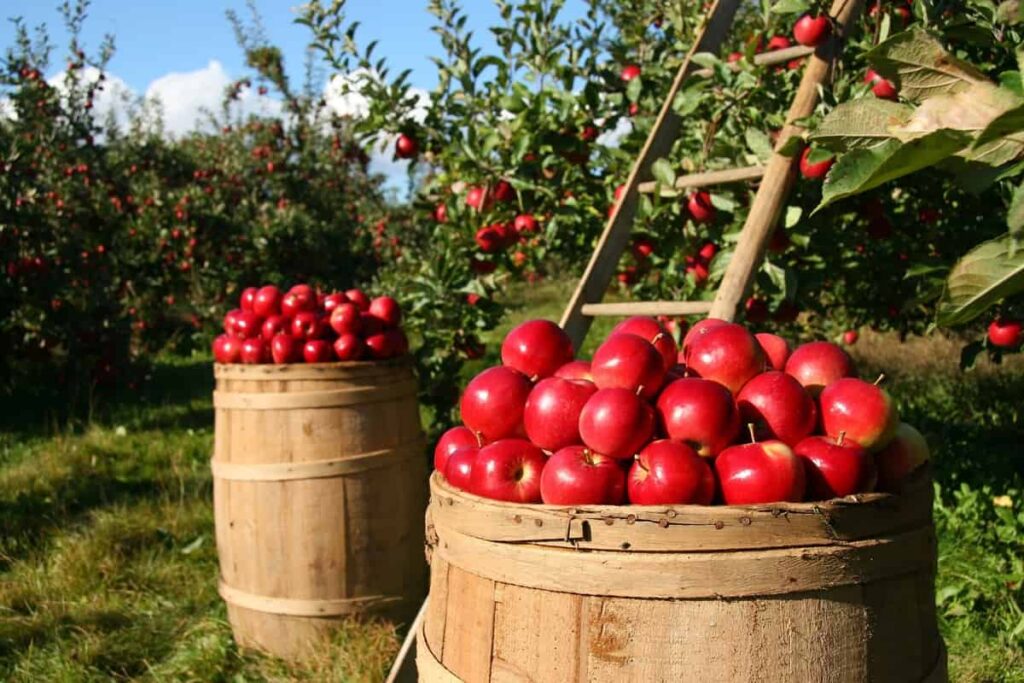
Chemical control and management
- Pruning and treatments with lime and sulfur, sulfur alone, or certain horticultural oils can be used to treat organically certified produce.
- Use Tebuconazole or Trifloxystrobin to control powdery mildew effectively. Most effective when applied before rainfall and allowed to dry. Apply at 5–10% bloom and make a second application at 80–100%.
- Apply myclobutanil at 400 gal/acre. Continue applications through the second cover spray at 7- to 10-day intervals. Use a high label rate if the disease was present in previous years for application by ground equipment only.
Sooty blotch
The disease is caused by Phylachora pomigena. Spores of the fungi are windblown into the plantation. The disease outbreaks are favored by long continuous periods of above-normal summer temperatures with frequent rainfall and high humidity. The fungal growth may leave discoloration behind. It affects the leaves, twigs, and fruits of a wide range of woody and herbaceous plants. Spores are produced in spring and early summer.
Disease symptoms
- On the fruit surface, sooty blotches appear as dark or cloudy spots. In addition, olive green scars with a tentative outline are visible.
- It is common for the scars to be one-fourth of an inch or larger in diameter and to cover most of the fruit.
- Hundreds of minute, dark pycnidia are interconnected by a mass of loose, interwoven dark hyphae, giving the “smudge” appearance.
- Sooty blotch fungus generally affects the outer surface of the cuticle. Sometimes, however, hyphae can penetrate between the epidermal cell walls and the cuticle.
Chemical control and management
- Sprays of strobilurin fungicide, kresxim-methyl, or trifloxystrobin have been evaluated to control sooty blotch. And thiophanate-methyl.
- Captan, Inspire Super, and other pre-mixes are believed to provide good control but are not quite as effective. Spray Mancozeb 75% WG (3G/L) of water and use spray fluid of 10 L of spray fluid/tree.
Brown rot
Apples suffer from brown rot caused by the fungus Monilinia fructicola. Typically, it is associated with nearby infected stone fruits more susceptible to the disease. A brown rot fungus survives the winter inside dead fruit or wood called a canker. As the spring season approaches, the fungus produces spores that spread with the wind and rain. The spores can infect blossoms and young fruit on stone fruit trees, but apple infection occurs when the spores enter through breaks in the skin of mature fruit. Infected trees can be controlled with fungicide sprays and sanitation.
Disease symptoms
- Enlarged rots are soft but not mushy.
- Circular and medium brown during the early and medium stages of development.
- The decayed area enlarges; small black spots about 1/8 inch across gradually develop at the lenticels
- The entire fruit is decayed and, under warm conditions, turns black and develops a velvety sheen.
- In warm, moist conditions, gray to tan fungal tufts develop in varying-sized patches or scattered over the decayed surface.
Chemical control and management
- It is possible to control infections with diluted solutions of copper fungicide mixed with liquid lime sulfur.
- Captan is commonly used as a fungicide spray to prevent apple fruit rot. The fungicide captan stays on the apple’s surface and stops the fungus from producing energy.
- Complete protection can be obtained by combining Captan with thiophanate-methyl.
In case you missed it: How to Grow Apples for Beginners: A Guide to Planting to Harvesting
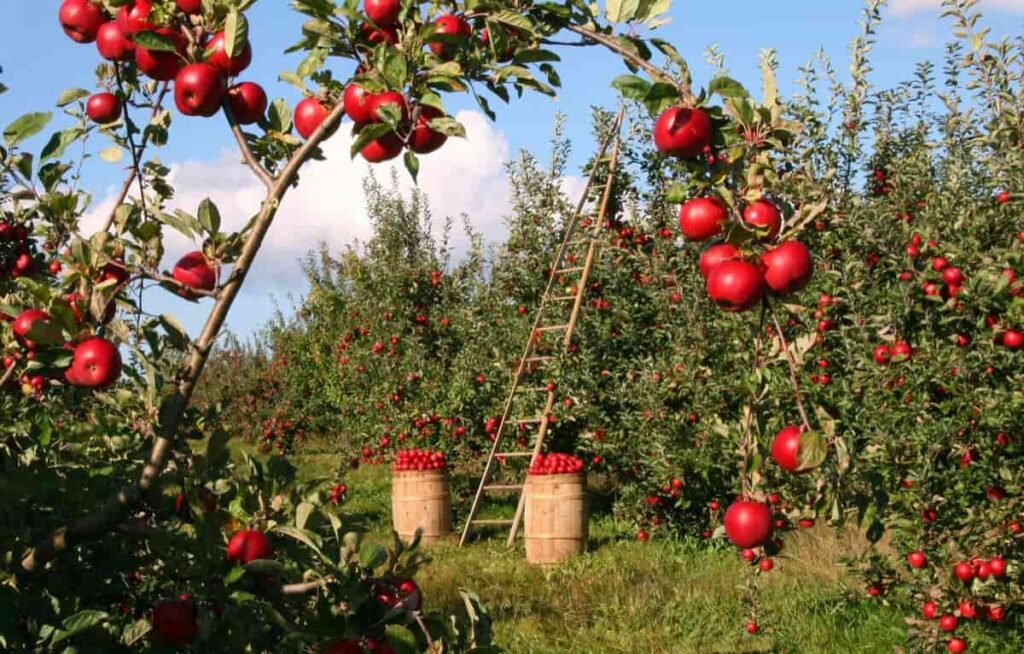
Pests in Apple trees
Codling moth
Although the codling moth is one of the most damaging apple pests, properly timed treatments can effectively control it. The codling moth has a wingspan of 0.5 to 0.75 inches. A coppery-tinted, dark brown band adorns the tip of each codling moth’s forewing, distinguishing it from other apple orchard moths.
Damage symptoms
- It is a natural pest and hence causes severe damage to the fruit.
- Neonate larva enters the fruit through the calyx and feeds on the seed.
- Fruits infested with pests lose their shape and fall prematurely.
- 30 to 70 percent of apple fruits are rendered unmarketable.
Biological control
- Earwigs and mirid bugs prey on codling moth eggs. Also, wasps such as Trichogramma parasitize codling moth eggs
- Mastrus ridens is a parasitoid wasp introduced and released into commercial orchards to attack codling moth larvae in their cocoons.
Chemical control
- Codling moths can be treated with an all-purpose fruit tree insecticide, pyrethroids (permethrin, esfenvalerate), or carbaryl.
Apple stem borer
It is a typical long-horned beetle (also called longhorn or longicorn beetle) in which the body is elongated, and the antennae are as long as or longer than the beetle’s body length. It is a stem-boring pest in natural and planted forests and fruit trees. It attacks hardwoods and at least one conifer primarily. Both healthy and stressed trees are attacked, often leading to crown dieback and possibly tree death after one or more years of infestation.
Damage symptoms
- Caused by grub and adult, grub is more destructive
- Grubs create a tunnel and reach close to the trunk of the tree.
- The vitality and productivity of the plant are significantly impaired.
Biological control
- Use parasitic nematodes such as Stienernema Pravassos and Heterorhabditis spp., and natural enemies such as Neoplectana nematodes and Elatrid beetle.
- Inject Beauvaria bassiana into larval holes.
Chemical control
- Inject 10 ml of monocrotophos 36 WSC and plug it with wet clay to kill the grub
- Spray dimethoate 30% EC at 594-792 ml in 600-800 l of water per acre
Tent caterpillar
Tent caterpillars are distinctive tree pests, spinning large webs or silken mats encompassing apple tree stems and branches. These foliage-feeding caterpillars can cause severe damage to individual trees, though they are rarely a widespread problem. Focused efforts combining cultural and chemical controls should quickly get a tent caterpillar infestation under control.
Damage symptoms
- Caterpillars rest at their nest during the night and the day; they feed on leaves.
- In severe infestation, the entire plant may be defoliated; subsequently, the caterpillar may feed on the bark of twigs.
- When a severe infestation occurs, 40 -50 percent of plants in the orchard may be defoliated, producing a poor harvest.
In case you missed it: Top 20 Steps To Boost Your Apple Fruit Yield: Fruit Size Increase Tips, and Ideas

Biological control
- When infestations are still small and accessible, tent caterpillars can be hand-picked from trees and dropped into a bucket of soapy water.
- Natural enemies often control tent caterpillars. For example, over 100 parasitic tachinid flies and wasps kill eggs, larvae, and pupae.
- Various predaceous beetles and bugs consume larvae. Birds eat eggs, larvae, and moths.
Chemical control
- Bacillus thuringiensis var kurstaki, or Bt, can be applied to the foliage of infested trees to treat young larvae.
- In extreme cases, diazinon, phosmet, azinphos-methyl, or chlorpyrifos can knock populations down quickly, but check the label for safety information regarding intervals between application and harvest if your apple is still in fruit.
- While Spinosad is also effective, it can adversely affect bees and other natural enemies. In addition, Spinosad is toxic to bees for several hours after it has dried, so do not spray it on plants when flowering.
Blossom thrips
A female lays approximately 200 eggs (about 200 eggs per female) on young leaves, flowers, and young fruits of plants. Usually, the adults live on young leaves, while the larvae live on older or lower leaves. These winged, sucking, rasping insects range in size from 5-14 mm. They have slender, pale bodies with silver stripes or black bodies with pale stripes. Several generations occur in a year, with spring being the most damaging.
Damage symptoms
- The leaf’s surface develops a crinkled silvery appearance due to damage to cells below the surface.
- Lightly-infested plants show silvery feeding scars on the undersurface of leaves, especially alongside the midrib and veins.
- Heavily-infested plants show silvering and browning of leaves, stunting of young leaves, and terminal growth, with fruit, scarred and deformed.
- Developing leaves become distorted in the growing tips.
Biological control
Predators: antlion, predatory thrips, ladybugs, anthocorids, lygaeids, etc.
Chemical control
Three insecticides, viz., Chlorpyriphos at 1ml/liter of water, Thiacloprid at 0.4 ml/liter of water, and Dimethoate at 1ml/liter of water, were evaluated for the control of apple blossom thrips and all the chemicals were found significantly effective against the pest at all the three phenological stages.
Conclusion
The trees are susceptible to several fungal and bacterial diseases and insect pests. Many commercial orchards pursue an aggressive program of chemical sprays to maintain high fruit quality, tree health, and high yields. A trend in orchard management is the use of organic methods. These use less aggressive and direct methods of conventional farming.
- How to Grow Hibiscus from Flower
- Plantation Ideas for Home Decoration: A Beginners Guide
- Flower Garden Designs and Layouts for Beginners
- Planting and Spacing Techniques in Papaya: A Beginner’s Guide
- Growing Gold: Essential Techniques for Planting Pineapples
- How to Make Kalanchoe Plant Bushy: Home Remedies and Solutions
- 11 Reasons Why Your Gardenia is Not Blooming: Home Remedies and Solutions
- Eco Elegance: The Guide to Designing a Drought-Tolerant Landscape
- Gardening on a Slope: Strategies for Hillside Landscaping
- Nourish and Flourish: Top Organic Mulches for Thriving House Plants
- Everything You Want to Know about Indian Mogra Flower: Discover Uses and Growing
- Green Thumb Success: Expert Tips for Cultivating Greenhouse Pumpkins All Year Round
- Maximize Growth & Flavor: The Ultimate Guide to Companion Planting in Herb Gardens
- How to Control Rhododendron Problems Naturally: Home Remedies and Organic Ways to Fix Them
- Natural Magic: The Remarkable Benefits of Cinnamon for Plants
- Best Steps to Revive Dying Tulip with Natural and Organic Treatment
- 10 Reasons Why Your Angel Trumpet is Not Blooming: Remedies and Treatment
- How to Fix Periwinkle Leaf and Flower-Related Problems: Natural Remedies and Solutions
- How to Fix Zinnias Leaf and Flower Problems: Discover Natural and Home Remedies
- Organic Steps to Induce Lemon Tree Flowers: A Comprehensive Guide
- Bloom Booster: Crafting the Perfect Homemade Bougainvillea Fertilizer
- Optimizing Growth: A Guide to Applying NPK Fertilizer for Potted Plants
- 10 Best Homemade Fertilizers for Rubber Plant: DIY Recipes and Application Method
- How to Boost Female Pumpkin Flowers: Effective Steps for More Flowers and High Yields
- Transform Your Indoor Garden: Top Benefits of Pink Salt for Houseplants
- 10 Best Homemade Fertilizers for Peacock Plants (Calathea): Easy DIY Guide
- Unlock Blooms: 9 Reasons Why Your Potted Chrysanthemum is Not Blooming
- 8 Reasons Why Your Potted Hibiscus is Not Blooming: Fix it with Simple Solutions
- Unlock Blooms: 9 Key Reasons Your Potted Frangipani Won’t Flower
- 10 Reasons Why Is My Ice Plant Not Blooming: Remedies and Treatment
- 10 Reasons Why My Potted Hydrangea Not Blooming: Treatment and Remedies
- 10 Reasons Why is My Wisteria Not Blooming: Remedies and Treatment
- 10 Reasons Why is My Goldfish Plant Not Blooming: Remedies and Treatment
- Maximize Your Space: Ultimate Guide to Balcony Gardening with Grow Bags
- 10 Reasons Why Your Iris is Not Blooming: Remedies and Treatment
- 10 Reasons Why Your Anthurium Plant is Not Blooming: Treatment and Remedies